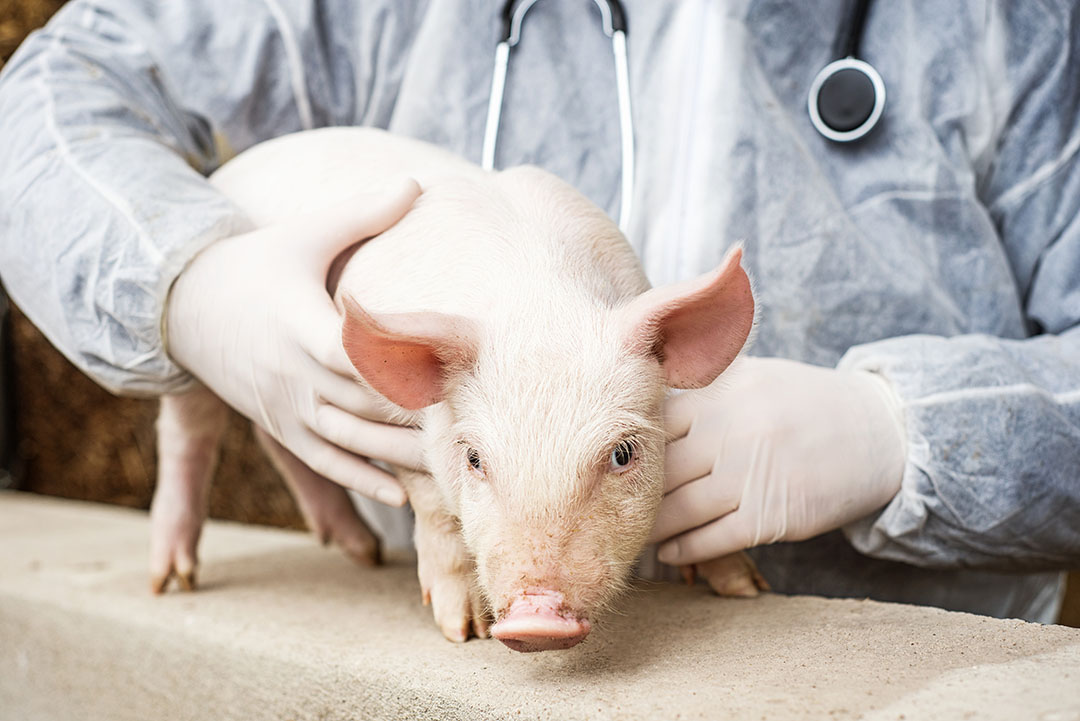Prevention is better than a cure

Preventive medicine is the future for pig production to control disease in an environment with limited or no antimicrobial use. A parenteral vaccine against ileitis proved to be safe whilst inducing a measurable immune response when trialled on two Canadian pig farms.
Adoption of preventive measures on pig farms will allow animals to express their real genetic growth potential. The best options to reduce the amount of antimicrobials during the growing period and to prevent diseases are planned herd health programmes that include pest controls, vaccination, biosecurity and disinfection. Such programmes result in economic benefits as they prevent and/or control subclinical and clinical disease development.
The most common grow-finish enteric disease is Porcine Proliferative Enteropathy (PPE) caused by Lawsonia intracellularis (LI). Clinical or subclinical presentations of PPE, also known as Ileitis, causes thickening of the intestinal wall leading to poor growth rate and feed conversion. During the clinical phase of the disease, 5-20% of the herd may have diarrhoea, combined with occasional mortality. Ileitis outbreaks are difficult to predict. PPE is controlled by in-feed antibiotics but on farms where such products are no longer acceptable, PPE vaccination can prevent the infection and reduce transmission. Merck Animal Health (MSD in Europe) has developed a parenteral vaccine, Porcilis Ileitis, as an aid in control of ileitis and to reduce the duration of faecal shedding of LI. In addition, the duration of immunity is at least 20 weeks. The product has been successfully applied in antibiotic free Canadian farms with either clinical or subclinical ileitis.
On farm field trials
Studies were carried out to assess the efficacy of the LI vaccine to control ileitis in a highly-challenged farm without antibiotics (RWA); to evaluate the safety of the vaccine; to assess LI faecal shedding and antibody titres in vaccinated and non-vaccinated animals and to determine effect of vaccination in a subclinical infected RWA farm. 2 field trials were conducted in 2 commercial farms raising pigs without antibiotics. In the first farm, severe losses due to PPE were observed. In the second farm, although no clinical disease was found, more than 50% of the animals tested prior to the start of the trial were shedding LI.
Farm 1: Approximately 2,500 pigs (10 weeks of production) from a 600-sow multi-site farrow-to-finish operation were included in the study. This farm had a PPE history in the continuous-flow finishing barns. From the weekly weaned pigs (approx. 250 piglets at three weeks of age), 90% were randomly allocated to a ‘vaccinated’ group and 10% to a control group. Both groups were housed together. All pigs were vaccinated intramuscularly with a Porcine circovirus and Mycoplasma hyopneumoniae combination vaccine (Circumvent PCV M G2). The treatment group was also injected IM with Porcilis Ileitis vaccine on a different side of the neck. During the first week, 30% of the vaccinated and 24% of the control pigs were weighed, and blood and faecal samples were collected to evaluate antibody titres and faecal shedding of LI at the time of vaccination (week 1) and at 11, 13, 17 weeks of age and prior to slaughter. Indirect fluorescent antibody test (IFAT) was used to analyse the serum for LI antibody response. Faecal shedding of LI was tested/examined with a qPCR.
Farm 2: In a 300 RWA sow herd with no apparent Ileitis clinical signs but with 50% of faecal samples positive by qPCR before vaccination, the Porcilis Ileitis effect on finisher pig weights was investigated. Weekly productions of piglets were randomly assigned at weaning to control or treatment group based on weight. Control pigs were vaccinated with Circumvent PCV M G2 as per label indications at 3 and 6 weeks of age. Treatment pigs were also vaccinated with the ileitis vaccination at weaning. The farm was equipped with an automated pig sorter with an electronic scale that read each pigs ear tag. Both treatment groups were mixed in the same pens; weights were collected individually at the end of the hot nursery and daily at the GF barn (70 days). Serology samples were collected from 30 pre-selected pigs in both groups and were tested with IFA for LI antibodies. Faecal samples were collected at the beginning and end of the trial from the same 30 pigs in both treatments and were examined for LI with qPCR.
Positive results per farm
Farm 1: One pig (0.04%) was observed with an anaphylactic reaction and recovered without any complications. Of the pigs sampled during the first week, 70% of pigs were LI seropositive. At the end of the nursery stage, all vaccinated pigs were LI seropositive and remained positive until 13 weeks of age. Control pigs had no detectable LI antibody titres at the end of the nursery or at 13 weeks. 56% of control pigs at 17 weeks of age and prior to slaughter had measurable LI IFA
titres (Figure 1). All pigs were negative for LI faecal shedding at the end of the nursery. At 17 weeks, 63% of vaccinated pigs and 28% of control pigs were negative or were low LI shedders, while 37% of vaccinated and 72% of vaccinated pigs were either medium or high LI shedders. As of 17.5 weeks of age (end of the study), the controls were all positive except one. None of the pigs had clinical signs of ileitis, either because they were never affected or they recovered.
Figure 1 – Farm 1: IFA titres in Porcilis Ileitis. Vaccinated vs Control pigs in a farm highly challenged with L. intracellularis and no antimicrobial use.

Farm 2: A total of 530 pigs were included in the study (265 pigs in each treatment). A total of 35,000 weight points of data were measured with a scale in GF. On average, vaccinated pigs were 1 kilogram heavier than control pigs at 20 weeks of age. The prevalence of subclinical ileitis in the herd was reduced from 50% to 23%, based on faecal LI qPCR results. All pigs were serologically negative for LI post-weaning. At 20 weeks of age, only vaccinated pigs had a detectable LI antibody response in IFA (Figure 2).
Figure 2 – Farm 2: IFA titres at slaughter age in Porcilis Ileitis. Vaccinated vs Control pigs from a farm with a low L. intracellularis challenge and no antimicrobial use.

The results of the field trials in two farms without antimicrobials and with either clinical or subclinical Ileitis, support that the vaccine induced a measurable immune response, which resulted in reduced level and duration of LI faecal shedding and increased weight at 20 weeks of age compared to controls. The reduction of LI shedding will likely also reduce the prevalence of bacteria in the environment and consequently the possibility of infection in AMF farms. Hence, it should be considered as an effective alternative in the control of ileitis.
References available on request
Author: Dr Francisco de Grau, Intervet Canada Corp. Merck Animal Health











